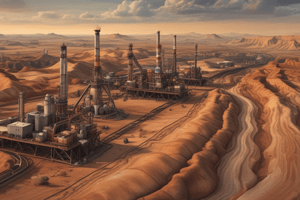Podcast
Questions and Answers
What does the principle of superposition state about rock layers?
What does the principle of superposition state about rock layers?
- Younger rocks are on top of older rocks. (correct)
- Rocks cannot be dated relative to each other.
- All rocks are formed simultaneously.
- Older rocks are always found at the surface.
What are index fossils used for in geology?
What are index fossils used for in geology?
- To identify the exact age of all rock strata.
- To provide a relative dating method. (correct)
- To create oil exploration maps.
- To measure tectonic shifts.
How can the relative age of rocks be determined?
How can the relative age of rocks be determined?
- By using radiometric dating exclusively.
- By analyzing the mineral content of the rocks.
- Only through archaeological findings.
- Through fossil records and stratigraphy. (correct)
What geological feature is described as being formed as a response to tectonic pressures?
What geological feature is described as being formed as a response to tectonic pressures?
What is radiometric dating most accurately used for?
What is radiometric dating most accurately used for?
Flashcards are hidden until you start studying
Study Notes
Oil and Gas Formation
- Oil and gas are found in geological formations that were formed millions of years ago.
- The principle of superposition helps understand the process, stating younger rocks are layered on top of older rocks.
- Uplift and mountain building events can push older rocks on top of younger rocks.
Stratigraphy and Fossil Records
- Stratigraphers study the succession of different rock strata and their context within the geological time record.
- Fossil records help correlate rocks globally, based on the preserved plant and animal life.
- Index fossils are specific fossils that help date rocks.
Dating Rocks
- Fossil records are used to determine the relative age of rocks.
- Radiometric dating provides accurate dates for rocks by testing volcanic ash within the sedimentary sequence.
Studying That Suits You
Use AI to generate personalized quizzes and flashcards to suit your learning preferences.




